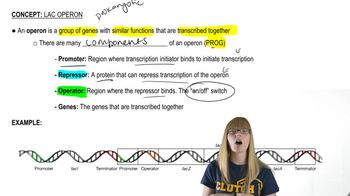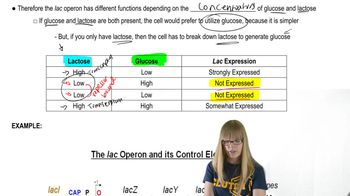Table of contents
- 1. Introduction to Genetics51m
- 2. Mendel's Laws of Inheritance3h 37m
- 3. Extensions to Mendelian Inheritance2h 41m
- 4. Genetic Mapping and Linkage2h 28m
- 5. Genetics of Bacteria and Viruses1h 21m
- 6. Chromosomal Variation1h 48m
- 7. DNA and Chromosome Structure56m
- 8. DNA Replication1h 10m
- 9. Mitosis and Meiosis1h 34m
- 10. Transcription1h 0m
- 11. Translation58m
- 12. Gene Regulation in Prokaryotes1h 19m
- 13. Gene Regulation in Eukaryotes44m
- 14. Genetic Control of Development44m
- 15. Genomes and Genomics1h 50m
- 16. Transposable Elements47m
- 17. Mutation, Repair, and Recombination1h 6m
- 18. Molecular Genetic Tools19m
- 19. Cancer Genetics29m
- 20. Quantitative Genetics1h 26m
- 21. Population Genetics50m
- 22. Evolutionary Genetics29m
12. Gene Regulation in Prokaryotes
Lac Operon
Problem 30b
Textbook Question
For an E. coli strain with the lac operon genotype I⁺ P⁺ O⁺ Z⁺ Y⁺, identify the level of transcription of the operon genes in each growth medium listed. Specify transcription as 'none,' 'basal,' or 'activated' for each medium, and provide an explanation to justify your answer.
Growth medium contains glucose but no lactose.
 Verified step by step guidance
Verified step by step guidance1
<span>Step 1: Understand the lac operon components and their roles. The lac operon in E. coli consists of the following components: I (lacI) is the repressor gene, P (promoter) is where RNA polymerase binds, O (operator) is where the repressor binds, Z (lacZ) encodes β-galactosidase, and Y (lacY) encodes permease.</span>
<span>Step 2: Identify the genotype provided: I⁺ P⁺ O⁺ Z⁺ Y⁺. This indicates that all components of the lac operon are wild-type and functional.</span>
<span>Step 3: Consider the effect of glucose on the lac operon. In the presence of glucose, catabolite repression occurs, which means that the presence of glucose inhibits the activation of the lac operon, even if lactose is present.</span>
<span>Step 4: Analyze the effect of lactose absence. Without lactose, the lac repressor (produced by I⁺) binds to the operator (O⁺), preventing transcription of the Z and Y genes.</span>
<span>Step 5: Conclude the transcription level. Since glucose is present and lactose is absent, the lac operon is repressed, resulting in 'none' or very low (basal) transcription levels.</span>
Recommended similar problem, with video answer:
 Verified Solution
Verified SolutionThis video solution was recommended by our tutors as helpful for the problem above
Video duration:
3mPlay a video:
Was this helpful?
Key Concepts
Here are the essential concepts you must grasp in order to answer the question correctly.
Lac Operon Structure
The lac operon in E. coli consists of several key components: the promoter (P), operator (O), and structural genes (Z and Y) that code for enzymes involved in lactose metabolism. The I gene produces a repressor that binds to the operator, preventing transcription when lactose is absent. Understanding this structure is essential for analyzing how the operon responds to different growth media.
Recommended video:
Guided course

Lac Operon Overview
Regulation by Glucose and Lactose
In the presence of glucose, the lac operon is typically repressed due to catabolite repression, a mechanism where glucose inhibits the production of cyclic AMP (cAMP). Low cAMP levels prevent the activation of the CAP (catabolite activator protein), which is necessary for the transcription of the lac operon. This regulation is crucial for determining transcription levels in media containing glucose but no lactose.
Recommended video:
Guided course

GAL Regulation
Transcription Levels: None, Basal, Activated
Transcription levels can be categorized as 'none' (no transcription occurs), 'basal' (minimal transcription occurs due to leaky expression), or 'activated' (high levels of transcription). In the context of the lac operon, when glucose is present and lactose is absent, transcription is typically 'none' because the repressor is bound to the operator, blocking RNA polymerase from initiating transcription.
Recommended video:
Guided course

Eukaryotic Transcription

 4:27m
4:27mWatch next
Master Lac Operon Overview with a bite sized video explanation from Kylia Goodner
Start learning


